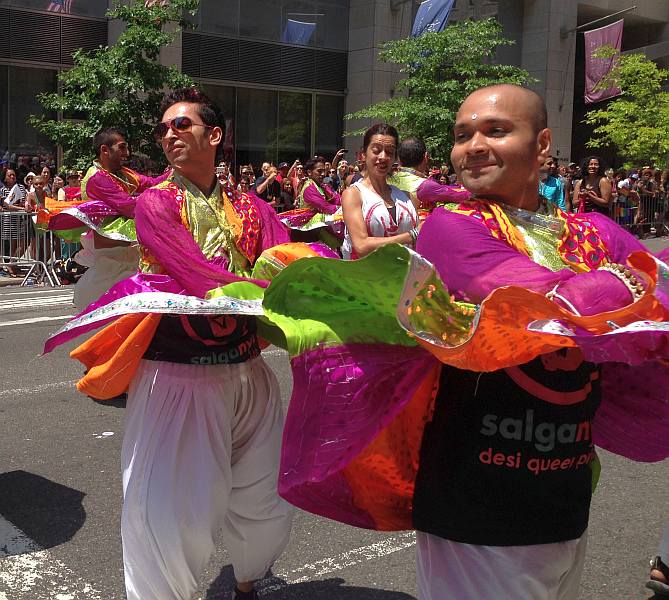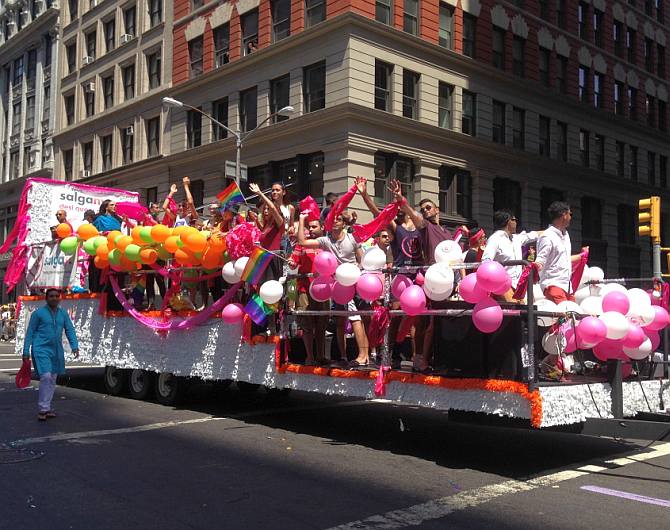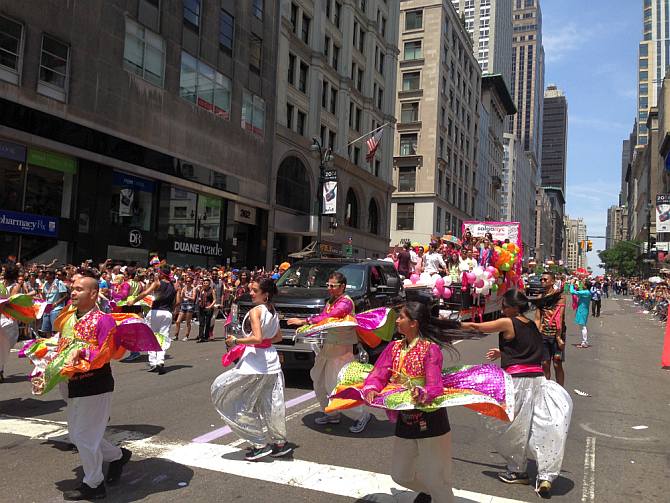
Chaya Babu discovers how the SALGA float went from struggling to get people to show up to being one of the most vibrant contingents at the NYC Pride Parade
After many years of absence, I braved the Pride March,' Sarah Schulman's Facebook status read June 30.
'The aesthetics of the parade are appalling. What was once the most creative and expressive community is riddled with repetition and banality. Most contingents looked the same -- noted exception: SALGA and The Caribbean Queers.'
The previous day, the colours of SALGA twirled down Fifth Avenue in the Village before turning on to West 9th toward Christopher Street. It was the 45th anniversary of the Stonewall Riots, violent demonstrations staged by New York's gay community and sparked by a police raid in 1969, marking what is considered to be the most significant catalyst to the Gay Rights Movement.
Every year at this time, the LGBT community in New York gathers to march in the Pride Parade, commemorating that historical moment, celebrating the progress that has been since, and simply taking joy in making itself visible to the public -- a particularly symbolic gesture for a group that has long been forced into the closet.
For the South Asian queer community, this has been the case even more so, and thus its presence in the parade and other Pride events has an added layer of significance.
 |
"I think it's important to understand that any mainstream queer pride parade tends to be pretty white gay male dominated, but then it becomes that much more important for us to make sure we're representing all of our colours, all of our cultures, all of our various gender and sexual identities, all of us," Navid Ladha, outgoing president of SALGA NYC, the desi queer association in New York told India Abroad in New York. "So just because it is white gay male dominated, that doesn't mean there isn't an opportunity to create space for others. I think that's what SALGA is doing in a way."
SALGA, formed over 20 years ago, is a non-profit volunteer organisation, but less formally it's a space for anyone who identifies as South Asian and queer. Pride is a time when those in the community can join together with the larger queer community in New York, and make themselves known loudly and proudly; Ladha explained that when registering for the parade, the group requests to be in the people of colour contingent.
"We make sure that we're aligned with Q-Wave, QPIMNY, Audre Lorde Project, the Indo-Caribbean Alliance, whatever the other participating POC organisations are," he said. "And that's important because then we really make a cultural impact at this event."
SALGA has been marching in the Pride Parade since its inception, but the last few years have seen its presence grow in size and vibrancy with the birth of the SALGA Dance Team, which led the float through the procession in the Sunday afternoon sun.
SALGA hosts and partakes in many events throughout the week, including Trans Day of Action, brunch at Dhaba, the Desilicious Hot Pink Pride party at Pacha nightclub, and the colour Me Queer party, which is a continued post-parade celebration. They even have a gathering where parents are invited, creating an intentional space where people can share and discuss the experience of having a queer family member.
Still, the Manhattan parade is the biggest, most anticipated and publicised event in Pride.
Ladha described the evolution of SALGA's involvement, saying that at one time it was simply about getting people to show up in numbers.
"I know that there have been struggles in the community in terms of having people appear on a float or marching because that's pretty much saying you're out, and that might have been an issue in years past," he said. "I think now, a lot of people show up, and if they do that means they're out, they're comfortable, they're okay with having their pictures taken there, they're okay with being seen on TV or in newspapers. It takes a certain amount of comfort with being out to be featured in the media that way. I think we see that more and more now -- there's such a sense of community."
"I think it's like you find your chosen family, and when you live in a place like New York where you have such a vibrant desi queer world, everyone kind of comes together."
Piali Mukherjee, who has been marching with SALGA since 1996, mentioned that one of the most positive changes she has seen in recent years is the increased presence of gay women and trans people showing up, signifying the further breaking down of taboos.
And SALGA is taking things a step further.
Please click NEXT to continue reading

In an approximately three-and-a-half minute performance, 18 dancers, decked out in shiny Gujarati outfits in colours that reflect the pink and orange SALGA logo, busted a move on Fifth Avenue.
"I think it makes the connection between being queer and South Asian -- people see us on the float and hear Bollywood music and are like, 'Okay, I get it,'" Ladha said. "And then having the dance team come out and showcase the creativity really gets people excited and into it."
To a sequence that combined Beyonce's Partition, Ang Laga De from Goliyon Ki Rasleela Ram Leela, and a mash up of Nagada Sang Dhol and Tattad Tattad also from Ram Leela, the troupe did a number that featured Bollywood moves, bits of other classical Indian dance forms, and some hip-hop and modern dance influences as well.
"This year we sort of played on two very strong points: Sexuality and a play on masculinity and femininity or gender roles in general," said Rohan Sheth, the choreographer. "The Beyonce piece has a certain notion of the whole traditional gender binary and things like that and having men get into that, especially in the South Asian community, is not something you see every day."
"The reason we picked Ang Laga De is because that song is really full of sexuality and sensuality, and by being able to dance to that with a South Asian choreography that is based in forms like Bharata Natyam and do it in pairs that were same sex, we felt like we did something really cool with that. We had some super stereotypical Bollywood hip shaking, but at the same time we were pushing the envelope a little bit."
The SALGA Dance Team, which has grown from 12 last year and even smaller numbers in years prior, did a coordinated, synchronised, rhythmic "dance-march," as Sheth called it, throughout the parade, and then had 30 seconds to give their all in front of a panel of judges.
"When were done, the announcer said, 'You guys put the wood in Bollywood...' it was very cute," Sheth laughed.
They will find out if they won any kind of award next month. Either way, he said, both the dancers and the others on the float had a blast, soaking up the energy and spirit of unity that was palpable at Pride.
Nearly 50 people were on the float, which was decorated with pink, orange, green, and white balloons and co-sponsored by Sholay Productions, a queer South Asian event management group. Prominent SALGA signage covered the sides, and smiling desi faces beamed from the top of it.
"We used to just have a pick up truck with some speakers in the back with a DJ mix, not an actual DJ," Mukerjee said. "Sometimes there would be a drag queen on top to add some colour, but it's been the past few years we've had the float, and that's been great. I think there's more accessibility in some ways for (the parade) to be quirkier. I feel like -- and this is my view as I'm getting older -- it used to be much more just everybody gathering together, like there was more of a sense of a movement, and now it feels more like a party."
Please click NEXT to continue reading

Ladha said when he came on a few years ago to help out he decided it was time to up the effort that went into the float's appearance.
"That's when we really started paying attention to graphics and posters and having a voice, versus just slapping a bunch of Indian flashy fabrics onto the float," said Tariq Fiaz, who works in fashion and was brought on to design the float because of his creative eye.
Fiaz started planning for the float in March to ensure that the look and theme were reflective of the community and something that people would recognise and connect to SALGA. But the real team effort of putting it together happened quickly on the morning of the parade and through the power in numbers -- in a matter of 25 minutes, about 20 SALGA members made it happen.
The dance preparation, however, was a different story.
The Dance Team started practicing months ago, getting together once a week for two to four hours to get the routine down right. Along with the funds raised for the float materials and costumes, which came to a total of about $5,000, SALGA also paid for the dance practice space.
Sheth explained that having the team come together regularly throughout the year, not solely for the purpose of rehearsing for the parade, was a meaningful outlet of artistic expression for queer desis because of the emphasis on music and dance in the culture. The goal was to offer a space for them to make art that somehow evoked their identities and to create more visibility for South Asians in the gay world and for gays in the South Asian world, he said.
The dance team will use the number they put together for the parade at other events and functions, and they also had a chance to perform it on stage at the Queens Pride, which took place just weeks earlier.
Sheth said, "Being a queer person of colour and being able to represent yourself is really important so people know that we're here, we're doing what we do, this is how we do it. When it comes to the desi community, there are still a lot of barriers, stereotypes, things people have to go through to be accepted. In a lot of ways the dance team bridges a cultural divide between people feeling like 'I have my gay life and I have my South Asian life and they're separate.' Because we're creating some play on being South Asian -- through the music and moves and whatever we do -- and also on being gay by just physically being in a space of queer South Asians, the pieces that we do have some sort of connection to our sexuality."
"I think when we present this to broader audiences, and we do it with as much passion and precision as we do, it's automatically bringing to the fore that yes, we're gay, but we're still South Asian. We still love our culture.'"